Introducing your baby to solid foods is an exciting milestone, and the baby food chart will help guide you through each step. So, when should you start? At 6 months, most babies are ready to begin solids. What foods should you start with?
Single-ingredient purees like sweet potatoes, apples, and rice cereal are perfect for the early stages. And how do you know when to move to the next stage? You can introduce more textures and flavors as your baby gets comfortable with solids.
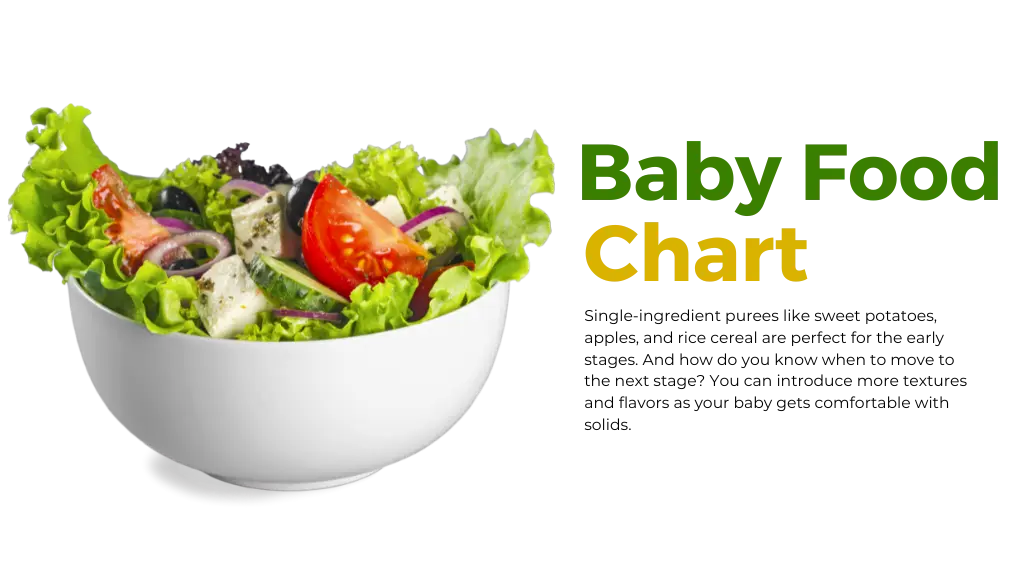
This article will walk you through each feeding stage, from milk-only meals to more adventurous toddler foods. You’ll get tips on what to feed your baby, when to feed them, and how to make mealtimes fun. Ready to dive into your baby’s food journey? Let’s get started!
0-6 Months: Milk is the Main Meal
During the first six months of life, your baby’s diet should consist entirely of breast milk or formula. Why? Because milk is packed with everything your baby needs to grow and develop. It’s like a magic potion that gives your baby all the nutrients they need for the day.
Why Milk?
Milk provides essential nutrients such as protein, fat, vitamins, and minerals, which help build a solid foundation for your baby’s growth. Breast milk, in particular, contains antibodies that protect your baby from infections and illnesses. It’s nature’s best!
At this stage, your baby’s digestive system is still developing, and they are not yet ready to process solid foods. Introducing solids too early can cause digestive issues, allergies, and choking hazards.
Here’s a simple table for a 0-6 month food chart:
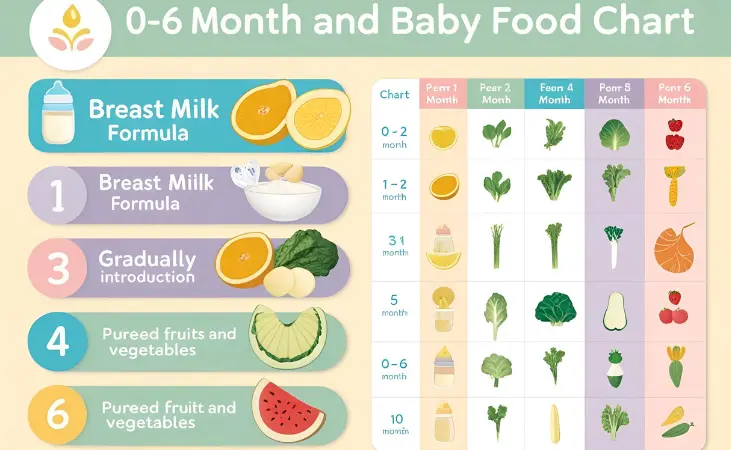
| Age | Food Type | Notes |
| 0-6 Months | Breast milk or formula | Milk is the primary source of nutrition. |
| Exclusive breastfeeding | Recommended for the first 6 months. |
It’s important to note that some babies may need formula if breastfeeding isn’t an option. Either way, you ensure your baby gets the nutrition they need to thrive!
6-8 Months: Starting Solid Foods
Around 6 months, your baby’s body will be ready for solids! You might wonder, “How do I know when it’s time?” If your baby shows interest in your food, can sit up with support, and has good head and neck control, it’s a sign they’re ready to explore new tastes and textures.
First Foods: Simple and Gentle
Start with simple, single-ingredient purees. Think of foods that are mild and easy for your baby to digest. Some good options include:
- Rice cereal (fortified with iron)
- Pureed fruits (like apples, pears, or bananas)
- Pureed vegetables (like sweet potato, pumpkin, or carrot)
- Pureed meats (like chicken or turkey)
These foods are great because they’re packed with vitamins and minerals that help your baby’s growth, but they’re still soft and easy to swallow.
Introducing New Flavors
At this stage, it’s essential to introduce just one food at a time. This will help you spot any food allergies early on. Once your baby has gotten used to one food (usually after 3-5 days), introduce another!
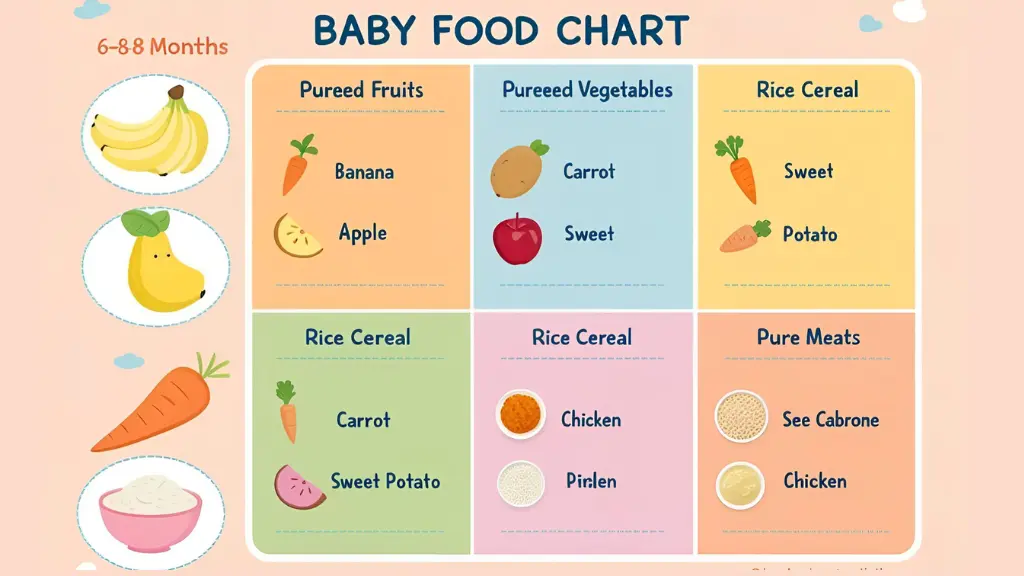
Here’s a simple table for the 6-8 month baby food chart:
| Age | Food Type | Notes |
| 6-8 Months | Pureed fruits | Start with soft fruits like apple or pear. |
| Pureed vegetables | Sweet potato and carrot are great choices. | |
| Rice cereal | Mix with breast milk or formula for smoothness. | |
| Pureed meats | Try chicken or turkey for added protein. |
8-10 Months: Exploring Textures and Flavors
By now, your baby is getting the hang of solid foods. They may start showing interest in using their hands to pick up food and even want to try feeding themselves. It’s an exciting time, as your baby’s taste buds are evolving, and you can start introducing a wider variety of foods and textures.
Moving Beyond Purees
You can offer mashed foods, soft finger foods, and even small pieces of cooked vegetables at this stage. The key is ensuring the foods are soft enough for your baby to chew safely, even without teeth.
Good foods to try:
- Mashed potatoes or sweet potatoes
- Steamed vegetables (like peas, carrots, or broccoli)
- Cheese (cut into small cubes)
- Soft fruits (like peach or melon)
- Oatmeal or porridge
- Small pieces of pasta
This is also a good time to introduce proteins like beans and tofu.
Here’s an 8-10 months baby food chart:
| Age | Food Type | Notes |
| 8-10 Months | Mashed vegetables | Try mashed sweet potato, peas, or carrots. |
| Cheese cubes | Soft cheese cut into small cubes. | |
| Steamed fruits & veggies | Easy-to-grip foods like bananas or peas. | |
| Pasta | Small pieces of pasta for self-feeding. |
10-12 Months: Moving Toward Family Meals
As your baby reaches the 10-12 month mark, they’re becoming more independent, and it’s time to introduce foods similar to what the rest of the family is eating. This is where meal times become more fun because your baby can begin to enjoy more variety!
Full Meals for Your Baby
Your baby can now eat the same meals as you, but make sure the foods are still cut into small, manageable pieces. Soft and tender meats, small pieces of vegetables, and fruits are perfect for this stage.
Great foods to include:
- Small pieces of chicken or fish
- Soft scrambled eggs
- Rice or quinoa
- Full-fat yogurt
- Small whole-wheat bread pieces
- Cooked vegetables like zucchini or spinach
At this stage, your baby will also learn to use a spoon and drink from a cup, so be patient as they transition to more complex meals.
Here’s a 10-12 month baby food chart:
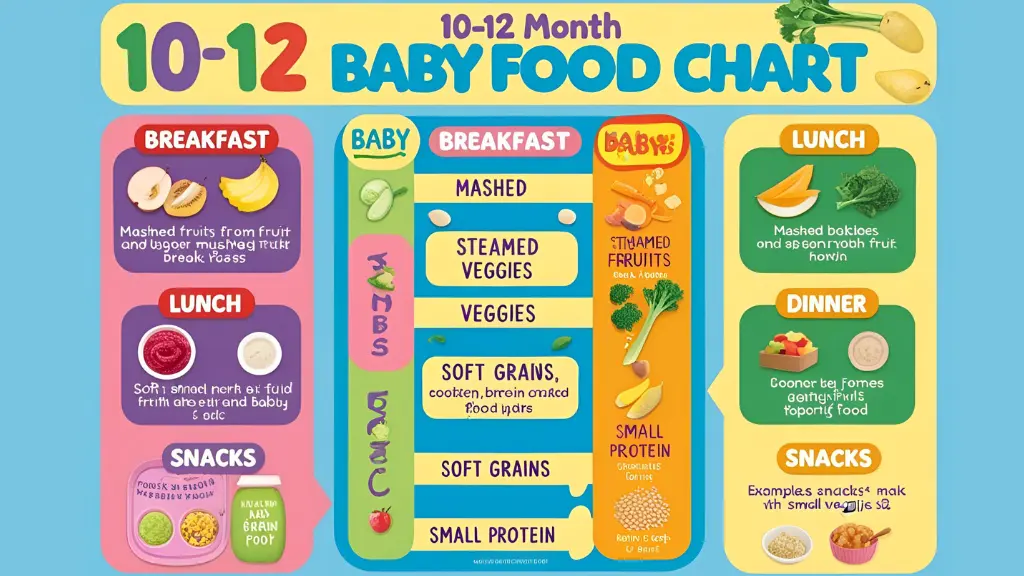
| Age | Food Type | Notes |
| 10-12 Months | Small pieces of chicken | Shredded or finely chopped for easy chewing. |
| Scrambled eggs | Soft and easy to chew, full of protein. | |
| Soft vegetables | Zucchini, spinach, or peas cut into small pieces. | |
| Rice or quinoa | It’s a great side dish with protein. |
12+ Months: Transitioning to Toddler Meals

Once your baby hits the 12-month mark, it’s all about preparing them for life as a toddler! By now, your baby is used to eating three meals a day, with a few snacks in between.
A Full Plate for Your Growing Toddler
Your little one is now ready to enjoy various foods, including whole grains, dairy, spice, and flavor. This is also when your baby’s transition to regular family meals becomes more seamless.
You can offer:
- Whole grain cereals
- Pasta with tomato sauce
- Sliced fruits
- Small pieces of meat, like beef or lamb
- Dairy, like milk, cheese, and yogurt
At this stage, your toddler might start expressing preferences for certain foods, so keep offering a variety to ensure they get all the necessary nutrients.
Here’s a 12+ months baby food chart:
| Age | Food Type | Notes |
| 12+ Months | Whole grains | Brown rice, whole-wheat pasta, or oatmeal. |
| Dairy | Milk, cheese, and full-fat yogurt. | |
| Sliced fruits | Easy-to-eat fruits like bananas or apples. | |
| Meat and poultry | Offer small pieces of beef, chicken, or turkey. |
Tips for a Smooth Feeding Journey
- Take it slow: Don’t rush the introduction of solid foods. It’s okay if your baby doesn’t love a new food immediately. Keep offering it at different times!
- Make it fun: Meal times should be an enjoyable experience. Try making funny faces with the food or play with textures to keep your baby engaged.
- Model good eating habits: Babies are great imitators! Let them see you eating various foods; they’re more likely to try new things.
- Be patient with mess: Expect some spills, splatters, and food smashes. It’s all part of the learning process, so embrace the mess and enjoy the moment!
Conclusion: Nourishing Your Growing Baby
Watching your baby transition from milk to solids is an exciting journey, and following a baby food chart sets them up for a lifetime of healthy eating habits.
Start with simple foods, gradually increase the variety and textures, and always remember that taking your time is okay. Nourishing your baby is about more than feeding them—it’s about fostering healthy habits, expanding their palate, and enjoying the little moments together.
Enjoy every bite of this incredible adventure!
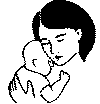
Pingback: Baby Food Chart by Age: A Simple Guide for New Parents - Baby Care Corner